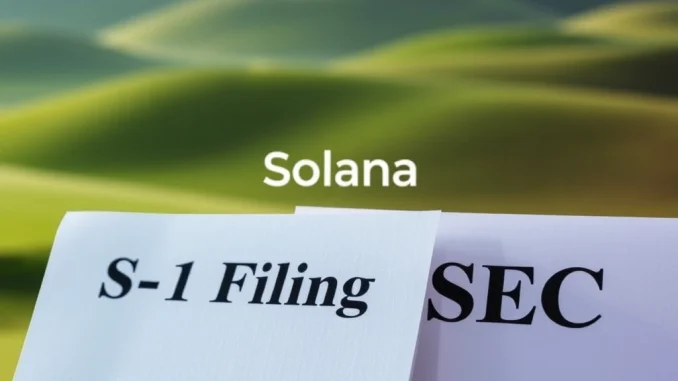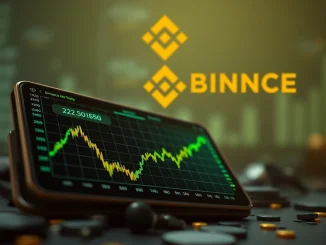
Hey crypto enthusiasts! Get ready for some exciting news from the world of Solana. The push for a Spot Solana ETF just hit a significant milestone, potentially opening new doors for investors looking to gain exposure to the popular blockchain. This development is a crucial step forward, but what exactly happened, and what does it mean for the future of Solana?
What Are These Crucial S-1 Filings for a Spot Solana ETF?
The buzz is all about the S-1 statements filed with the U.S. Securities and Exchange Commission (SEC) by several potential issuers of a Spot Solana ETF. According to reports, seven applicants have officially submitted these initial registration forms. Think of the S-1 as the first formal application – it’s where companies planning to offer securities to the public lay out their business plan, risks, and the details of the offering. For a Spot Solana ETF, this document outlines how the fund would operate, who is behind it, and how it would hold actual SOL tokens.
Why is this a big deal? Filing the S-1 signals serious intent from these financial firms. It shows they are actively working through the regulatory process required to potentially list and trade a Solana-backed exchange-traded fund on major U.S. stock exchanges.
Understanding the Path to SEC Approval
While the S-1 filing is necessary, it’s just one step on a potentially long road to SEC approval. As Bloomberg ETF analyst James Seyffart pointed out, there needs to be a “back and forth” between the SEC and the issuers. This dialogue involves clarifying details, addressing regulatory concerns, and refining the proposals.
This process isn’t typically fast. The SEC reviews these filings meticulously, often sending back comments and requiring amendments. Because of this expected interaction, approval isn’t likely to happen immediately, certainly not as soon as next week, despite the filings being submitted.
The path to SEC approval for cryptocurrency ETFs has historically been complex, marked by caution from the regulator. However, the approval of Spot Bitcoin ETFs earlier this year, and the ongoing process for Spot Ether ETFs, provides a potential roadmap and precedent for assets like Solana.
Solana Staking: A Key Element in the Filings
One particularly interesting detail highlighted by Seyffart is that staking is encompassed in all the S-1 filings. Staking is a process where SOL holders can earn rewards by participating in the network’s validation process. Including staking in the ETF structure could potentially offer additional yield to fund shareholders, making the product more attractive.
The inclusion of staking presents a new layer for the SEC to consider. Seyffart suggested that spot Solana ETFs “could theoretically” be rolled out with staking at the same time that the SEC approves staking for spot Ether ETFs. This implies that the regulatory stance on staking within an ETF structure for one asset could influence the outcome for others.
Key points regarding staking in the filings:
- All seven applicants included provisions for staking.
- This could potentially provide yield for ETF investors.
- Regulatory clarity on staking within ETFs is still developing.
- Approval might be tied to the SEC’s decision on staking for Ether ETFs.
Increased Odds for a Solana ETF?
Adding to the positive sentiment surrounding these developments, Bloomberg Intelligence recently raised its estimate of the likelihood that the SEC will approve spot Solana ETFs this year. On April 30, their projection increased to 90%. This significant jump reflects growing confidence among analysts that regulatory hurdles are being overcome and that a Spot Solana ETF is becoming a strong possibility in the near future.
While a 90% chance is high, it’s not a guarantee. The SEC’s final decision will depend on various factors, including market readiness, investor protection concerns, and their evolving stance on crypto assets.
What Happens Next?
The next steps involve the SEC reviewing the S-1 filings and providing feedback to the applicants. This iterative process of comments and amendments will continue until the SEC is satisfied or makes a decision to approve or deny the applications. Market participants will be closely watching for any signs from the SEC and updates from the filing firms.
Potential benefits of a Spot Solana ETF could include:
- Increased accessibility for traditional investors.
- Potential for greater institutional adoption of Solana.
- Improved liquidity for the SOL market.
- Price discovery driven by regulated financial markets.
However, challenges remain, such as:
- Navigating the SEC’s regulatory framework for crypto.
- Addressing concerns about market manipulation.
- The complexity of incorporating staking into a regulated product.
- Ensuring secure custody of the underlying SOL tokens.
Actionable Insights for Investors
For those interested in Solana or the broader crypto market, these S-1 filings are a signal of progress. While not a guarantee of imminent approval, they show the process is moving forward. Investors should continue to monitor SEC announcements and news from the firms that have filed. Understanding the potential impact of a Spot Solana ETF on market dynamics and price is key, but remember that regulatory processes can be unpredictable.
Summary: A Step Closer for the Spot Solana ETF
In conclusion, the filing of S-1 statements by seven applicants for a Spot Solana ETF marks a significant development in the quest for regulated investment products tied to Solana. While immediate SEC approval is unlikely due to the necessary review and “back and forth” process, the inclusion of staking in the filings and the increased confidence from analysts like Bloomberg Intelligence (raising odds to 90%) suggest a growing possibility of approval this year. The path ahead involves regulatory dialogue and addressing the complexities of incorporating features like staking, but the filing of these crucial S-1 documents undoubtedly brings the prospect of a Spot Solana ETF closer to reality, potentially reshaping how investors access the Solana ecosystem.



